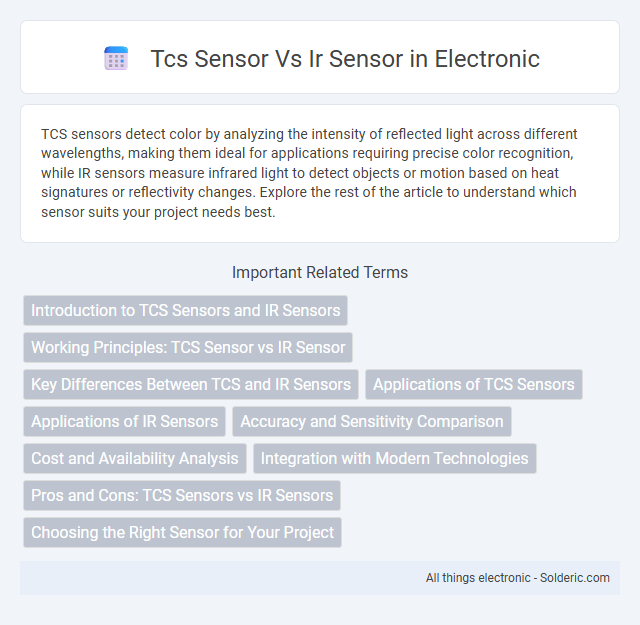TCS sensors detect color by analyzing the intensity of reflected light across different wavelengths, making them ideal for applications requiring precise color recognition, while IR sensors measure infrared light to detect objects or motion based on heat signatures or reflectivity changes. Explore the rest of the article to understand which sensor suits your project needs best.
Comparison Table
| Feature | TCS Sensor | IR Sensor |
|---|---|---|
| Full Name | True Color Sensor (TCS) | Infrared Sensor (IR) |
| Primary Function | Color Detection and Sensing | Distance Measurement and Object Detection |
| Operating Principle | Measures reflected visible light to determine color | Emits and detects infrared light for proximity sensing |
| Typical Applications | Color sorting, color recognition in robotics | Obstacle detection, line following, remote controls |
| Spectral Range | Visible light spectrum (approx. 400-700 nm) | Infrared spectrum (approx. 700 nm to 1 mm) |
| Output Type | Analog or digital RGB signals | Digital pulse or analog voltage related to distance |
| Common Models | TCS3200, TCS34725 | Sharp GP2Y0A21YK0F, TSOP38238 |
| Environmental Sensitivity | Highly sensitive to ambient light conditions | Less affected by visible light but sensitive to IR noise |
| Power Consumption | Moderate, depends on model | Low to moderate |
| Cost | Generally higher due to complexity | Generally lower and more widespread |
Introduction to TCS Sensors and IR Sensors
TCS sensors, or True Color Sensors, detect color by analyzing the reflected light spectrum, enabling accurate color recognition in various applications such as robotics and quality control. IR sensors, or Infrared Sensors, measure infrared radiation emitted or reflected by objects to detect proximity, motion, or temperature changes, commonly used in security systems and remote controls. Both sensors utilize different wavelengths and principles to provide critical data for automation and environmental monitoring.
Working Principles: TCS Sensor vs IR Sensor
TCS sensors operate by detecting the wavelength of reflected light to identify colors using photodiodes and filters, enabling precise color recognition based on light reflection. IR sensors function by emitting infrared light and measuring the intensity of the reflected IR beam to detect objects or measure distance, relying on the principle of infrared radiation absorption and reflection. The fundamental difference lies in TCS sensors analyzing visible light wavelengths for color detection, while IR sensors utilize infrared light primarily for proximity and motion sensing.
Key Differences Between TCS and IR Sensors
TCS sensors detect color by measuring the intensity of red, green, and blue light using photodiodes, making them ideal for applications requiring accurate color recognition. IR sensors emit and detect infrared light to measure proximity, distance, or motion, commonly used in obstacle detection and remote controls. Unlike TCS sensors focused on color data, IR sensors primarily operate based on heat signatures or reflected infrared light, emphasizing spatial awareness over color identification.
Applications of TCS Sensors
TCS sensors are widely used in applications requiring precise color detection and differentiation, such as in industrial automation for quality control and sorting systems. They play a crucial role in consumer electronics, enabling accurate color recognition in devices like printers and cameras. Furthermore, TCS sensors help enhance agricultural technology by monitoring plant health and detecting ripeness through color analysis.
Applications of IR Sensors
IR sensors are widely used for motion detection in security systems, remote control devices, and thermal imaging cameras. These sensors excel in non-contact temperature measurement and object detection, making them essential for industrial automation and healthcare monitoring. Their capability to detect infrared radiation enables applications in night vision and fire detection systems.
Accuracy and Sensitivity Comparison
TCS sensors excel in color detection accuracy by providing precise identification across a wide spectrum, making them highly sensitive to subtle color variations. IR sensors, primarily designed for proximity and motion detection, offer less accuracy in color differentiation but maintain high sensitivity to infrared light intensity changes. Your choice between the two depends on whether color accuracy or infrared sensitivity aligns best with your application requirements.
Cost and Availability Analysis
TCS sensors are generally more cost-effective due to their simple design and widespread manufacturing, making them readily available for various applications. IR sensors, while slightly more expensive, offer higher precision and are commonly stocked in electronics stores and online platforms, ensuring consistent availability. Your choice between TCS and IR sensors should consider budget constraints alongside the specific performance requirements of your project.
Integration with Modern Technologies
TCS sensors excel in color detection and accurate color sorting, making them ideal for applications requiring precise color recognition in robotics and quality control systems. IR sensors provide reliable proximity and motion detection widely used in automation, security systems, and smart home devices due to their ability to detect heat signatures and movement. Your choice depends on the specific technology integration needs, with TCS sensors favoring color-sensitive applications and IR sensors enhancing object detection and environmental interaction.
Pros and Cons: TCS Sensors vs IR Sensors
TCS sensors excel in detecting a wide range of colors and are highly accurate for color recognition tasks, making them ideal for applications requiring detailed color differentiation. IR sensors offer advantages in proximity sensing and object detection in low-light or dark environments, providing reliable performance without color sensitivity but often lack the precision for color-based identification. Choosing between TCS and IR sensors depends on whether your priority is detailed color detection or versatile distance and motion sensing.
Choosing the Right Sensor for Your Project
Choosing the right sensor for your project depends on the specific application requirements and environmental conditions. TCS sensors excel in detecting and distinguishing colors using RGB photodiodes, making them ideal for projects involving color recognition, while IR sensors are best suited for proximity detection and motion sensing through infrared light. Your decision should consider factors like accuracy, range, ambient light interference, and the type of data your project needs to capture.
tcs sensor vs ir sensor Infographic

 solderic.com
solderic.com